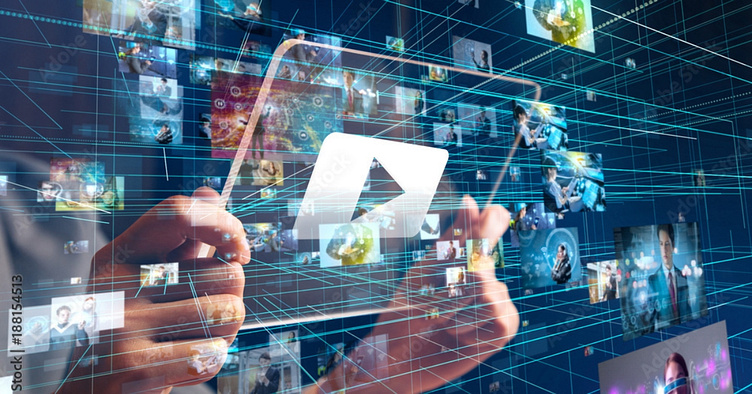The Future of Augmented Reality in Social Media
Imagine a world where the boundaries between the real and the virtual blur, creating a canvas where your digital interactions are as tactile as the texture of paper or as vivid as the sunset. This is the promise of augmented reality (AR)—a technology that grafts computer-generated enhancements atop our physical world, breathing life into the static and layers of depth into the flat screens of our mobile devices. And when this innovation converges with the pulsating realm of social media, it leads us in an era of transformation never seen before.
Augmented Reality in Social Media will be the new normal soon owing to the positive impacts it brings to the table. This blog talks about all things Augmented Reality and social media - filtering through the potentials, understanding the impact, and envisaging the future.
The Impact of Augmented Reality in Social Media
In today’s fast-paced digital landscape, Augmented Reality is not just a buzzword; it becomes a fundamental way of enhancing how we connect, share, and experience social media. Let us explore how AR is reshaping the fabric of social interactions, catalyzing brand engagement, and setting a new course for the future of digital marketing.
Enhancing User Engagement
Social media platforms like Instagram and Snapchat have pioneered the use of AR filters, introducing an element of playfulness that keeps users hooked. Gamification amplifies this allure, turning static ads into interactive challenges that resonate with the inner child in each user.
But it doesn’t stop there. Immersive storytelling via AR on platforms like Facebook and TikTok has opened a channel for brands and creators to impart narratives with a zest that text or static images could never achieve. Through AR, the stories leap out of the screen, creating a holograph-like presence that engages the senses and captivates attention like never before.
Boosting Brand Awareness
Imagine the impact when a brand steps off the billboard and into your living room—virtually, of course. Branded AR experiences have redefined brand-customer interactions, forging a memorable connection that static ads could hardly compete with. Through AR, products come alive; they can be demoed or trialed in real-time, without the user ever leaving their home.
Consider the potential seen in influencer collaborations. When an influencer dons a virtual watch or sunglasses through an AR-enabled app, the lines between real and virtual endorsements blur, piquing interest and curiosity. What used to be a mere recommendation becomes an engaging show-and-tell, stimulating a strong visual interest in the audience.
Driving Sales and Conversions
Bridging the gap between desire and acquisition, AR’s influence extends into direct sales through virtual try-on experiences. The immediacy of trying on a pair of glasses or seeing how a new sofa fits in your living room through a smartphone camera has revolutionized shopping behavior, leading to more confident purchases and reduced returns.
The charm of AR magnifies when linked with seamless in-app transactions. With a single tap, consumers move from virtual product trials to checkouts, streamlining the customer journey and bolstering conversion rates. And it’s not just random splurges—it’s targeted, personalized advertising that speaks directly to the consumers’ preferences and behaviors.
Revolutionizing Social Media Marketing
Within the bustling social media stage, personalized user experiences cut through the noise, positioning AR at the epicenter of a new-age marketing strategy. Data-driven insights gleaned from AR interactions offer a wealth of knowledge, enabling precise audience targeting and efficient campaign adjustments.
Platforms themselves are morphing to accommodate AR’s ascent. Instagram Stories’ AR features and Snapchat’s AR Lens showcase how seamless integration drives forward the adoption of these tools, making them indispensable for social media innovators and marketers alike.
Future Potential and Innovations
As we peer into the horizon, advancements in AR technology promise even richer, more immersive experiences. The coupling of AR with Artificial Intelligence (AI) and Machine Learning (ML) points toward an ecosystem of self-learning, context-aware AR content that adapts and evolves—a digital cosmos that mirrors our wants, reacts to our needs, and predicts our desires.
High fidelity graphics and real-time enhancements beckon a future where AR becomes indistinguishable from reality, charting new territories for creativity and interaction. The journey of AR in social media has only just begun, and the trail it blazes will redefine our digital dialogs and the very essence of how we ‘socialize’ online.
Key Takeaway
It is the time you integrate Augmented Reality into your social media strategies hereon. With AR, imagination is not an escape; it’s an engagement. With each filter, we don’t just see a new shade; we step into the shoes of digital pioneers, exploring, creating, and ultimately shaping the path that lays beneath the feet of the next digital revolution.
Continue to embrace, innovate, and propel this screen-centric voyage toward a reality more colorful, more vivacious, and unequivocally more connected. The future is bright; the future is augmented; the future is now. So, start creating AR for your social media. Consider doing it on no-code platforms like PlugXR. It is much easier, faster and hasslefree!
